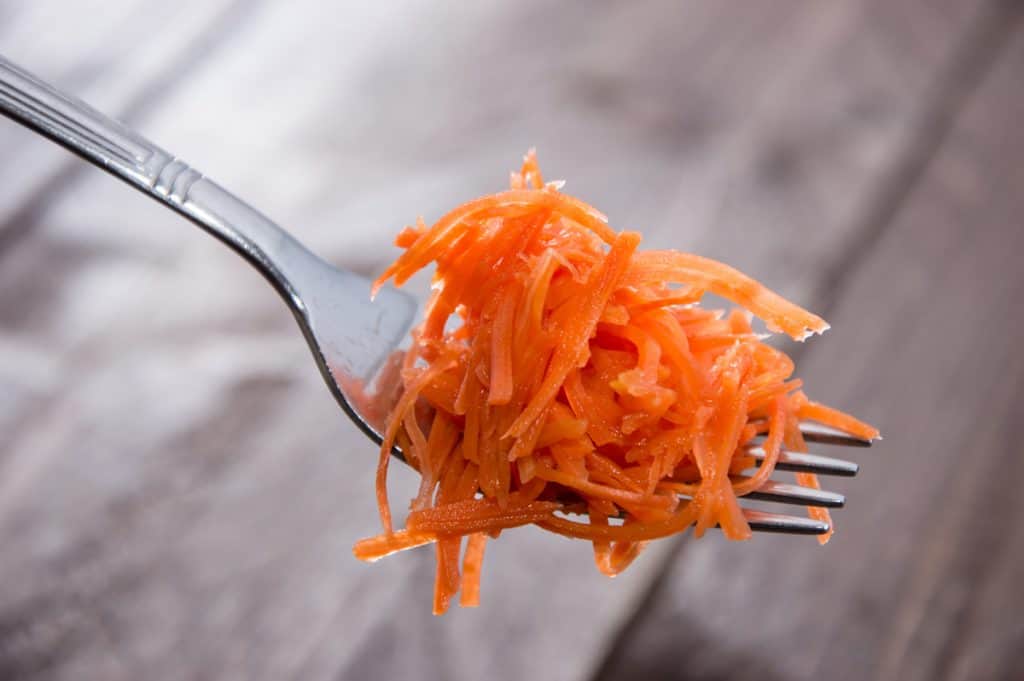

Lacto-fermented carrots are a delicious snack, especially because the sweetness of the carrots overcomes the sometimes sour flavor of fermentation. This is a great way to use up those last few carrots grown in your garden or that you have in storage. You can even make this from carrots bought from the store or farmer’s market.

Why I Love This Recipe
When you’re first introducing kids to ferments, they can sometimes be a little bit leery of the strong flavors. Making these fermented carrots is a great option because the kids tend to love the sweet flavor of the carrots.
Here is my list of the best foods to ferment, especially when just starting out.

Ingredients Needed
- Carrots – about 2 1/2 lbs (or 12-13 medium-sized carrots)
- Fresh ginger (or bottled minced ginger)
- Salt – Kosher, sea salt, celtic salt, himalayan salt, all will do, just be sure it’s free from anti-caking agents and that it’s not been iodized.
- Starter Liquid – this can be whey, or liquid from a previous batch of sauerkraut, kimchi, fermented pickles, or even a previous batch of ginger carrots. If you don’t have any starter liquid, double the salt.
Homesteading Hack: Don’t throw away the carrot tops. Use them to make carrot top pesto.
How to Make Fermented Carrots
- Shred carrots using a food processor or cheese grater and place into a large bowl.
- Add 1 tablespoon of minced ginger.
- Add 1/4 cup starter culture (the juice from a previous ferment such as homemade sauerkraut, or even whey) and 1 tablespoon salt. If you don’t have a starter culture for fermentation, add 2 tablespoons salt.
- Stir well to distribute salt and ginger throughout the carrots.
- Using the bottom of a wooden spatula, or a ‘kraut pounder, pound the carrots for about 10 minutes (much like you would when making sauerkraut) to release their juices. You can walk away and take a break as needed, but you will need to do about ten minutes of actual pounding.
- Place a funnel into a quart-sized wide-mouth Mason jar and add carrots to the jar. Pack down the carrots firmly as you go to eliminate air pockets, the goal is a tightly packed jar of carrots.
- Once your jar is full, add the remaining liquid from the bowl so your carrots are covered with liquid.
- Place a fermenting weight, or a small 1/4 pint jar inside the quart jar to hold carrots under the liquid.
- Add a lid, NOT airtight, and leave jar out on the counter for three days.
- After three days, taste the carrots to see if the flavors have developed. Once you’re happy with the flavor, transfer to cold storage (anything under 55 degrees F and above freezing). This could be a cool place in the pantry, a wine cooler, a root cellar, or for many of us, the refrigerator.

More Fermented Recipes
- Apple Jalapeño Sauerkraut Recipe
- Lacto-Fermented Sauerkraut
- Preserved Lemons
- Preserved Limes With Fermentation
- Easy Homemade Lacto-Fermented Mayo
- Lacto-Fermented Green Beans (Pizza Beans)
- Fermented Tomatoes
- Fermented Cranberry Sauce
Did you make this recipe? If so, we’d love for you to leave a star rating in the recipe card below. Then snap a photo and share it on social media, and be sure to tag us @homesteadingfamily so we can see! Also, get more recipes like this, along with other homesteading tips by following us on Pinterest, Facebook and our YouTube channel.

Fermented Ginger Carrots
Equipment
- Mason Jar with Lid
Ingredients
- 12 medium carrots about 2 1/2 pounds
- 1 Tablespoon ginger minced
- 1 Tablespoon sea salt 2 Tablespoons if omitting starter culture
- 1/4 cup whey or another starter culture
Instructions
- Shred carrots using a food processor or cheese grater and place them into a large bowl.
- Add 1 tablespoon of minced ginger.
- Add 1/4 cup starter culture (see notes for options) and 1 tablespoon salt. If you don’t have a starter culture, add 2 tablespoons salt.
- Stir well to distribute salt and ginger throughout the carrots.
- Pound the carrots for about 10 minutes (much like you would when making sauerkraut) to release their juices.
- Place a funnel into a quart-sized wide-mouth Mason jar and add carrots to the jar. Pack down the carrots tightly as you go to eliminate air pockets, the goal is a firmly packed jar of carrots.
- Once your jar is full, add the remaining liquid from the bowl so your carrots are covered with liquid.
- Place a fermenting weight, or a small 1/4 pint jar inside the quart jar to hold carrots under the liquid.
- Add a lid, do not screw down airtight, and leave the jar out on the counter for three days.
- After three days, taste the carrots to see if the flavors have developed to your liking. If not, continue to let ferment, tasting every 12 hours.
- Once you’re happy with the flavor, transfer to cold storage (anything under 55 degrees F and above freezing). This could be a cool place in the pantry, a wine cooler, a root cellar, or for many of us, the refrigerator.
Notes
- Double the salt if you’re not using a starter culture.
- A starter culture can be whey, or liquid from a previous ferment such as sauerkraut, fermented pickles, or even a previous batch of fermented carrots.
- You don’t have to pound carrots for ten minutes straight, but you will want a total of ten minutes of pounding time to ensure the carrots release enough juice to cover the ferment.
- Be sure to save the fermenting liquid in the jar for your next batch!


















